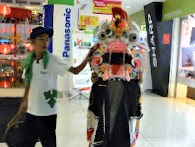In researching the history of my grandmother's family, the major discrepancy or rather controversy I encountered relates to the ages of my grandmother and her siblings.
Most of the people I talked to and who have some knowledge of my grandmother and her siblings seemed to agree that my grandmother was the eldest child among the five children. However, information shown in the tombstones and printed document revealed otherwise.
In the case of my grandmother, the birthday as inscribed on her tombstone is 13. 8 1913. In the case of Dungko, the birthday as inscribed on his tombstone is 9.9.1895. In the case of Rampas whose life is described briefly in a booklet compiled by some student researchers, 1907 is given as his year of birth. Even in the absence of the birthdays of the other two siblings, Gomingo and Kundipoi, Lotimboi could not be the eldest child based on the date of birth of his two brothers.
Secondly, the order of Rombis's children as given in the publication of Gomorun's descendants is: Dungko, Gomingo, Rampas, Kundipoi and Lotimboi. Whether it was the understanding of the compiler on the sequence or by coincidence, Lotimboi's name is shown as the last among the five siblings.
Thirdly, my sister recalled from her previous conversation with my late mother that my grandmother was indeed very "young" when she married my grandfather. She would be 14 when she married my grandfather in 1927 (a year before my mother's birth) if 1913 is adopted as her year of birth. However, if 1894 ( a year before the birth of Dungko) is chosen, she would be in her thirties when she married my grandfather in 1927.
I may be able to shed more light on this discrepancy if I can locate the offspring of Gomingo, a sister of my grandmother, Lotimboi to find out Gomingo's date of birth. In the meantime, I would stick to 1913 as my grandmother's year of birth. This would place her as the youngest rather than the eldest child!
Thirdly, my sister recalled from her previous conversation with my late mother that my grandmother was indeed very "young" when she married my grandfather. She would be 14 when she married my grandfather in 1927 (a year before my mother's birth) if 1913 is adopted as her year of birth. However, if 1894 ( a year before the birth of Dungko) is chosen, she would be in her thirties when she married my grandfather in 1927.
I may be able to shed more light on this discrepancy if I can locate the offspring of Gomingo, a sister of my grandmother, Lotimboi to find out Gomingo's date of birth. In the meantime, I would stick to 1913 as my grandmother's year of birth. This would place her as the youngest rather than the eldest child!


























































.jpg)
.jpg)